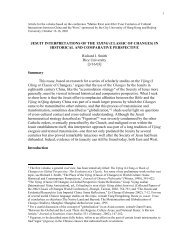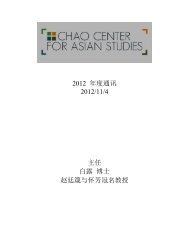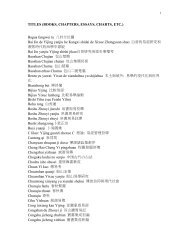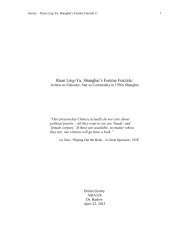Key Concepts of Fate and Prediction in the Yijing - Chao Center for ...
Key Concepts of Fate and Prediction in the Yijing - Chao Center for ...
Key Concepts of Fate and Prediction in the Yijing - Chao Center for ...
You also want an ePaper? Increase the reach of your titles
YUMPU automatically turns print PDFs into web optimized ePapers that Google loves.
27order to entice Confucians to know Chan.” Not surpris<strong>in</strong>gly, his work conta<strong>in</strong>ed a gooddeal <strong>of</strong> paradox; thus he described it as be<strong>in</strong>g about change (yi ), nonchange(feiyi ), <strong>and</strong> nei<strong>the</strong>r change nor non-change (lit. “not non-change;” feifei yi ).The Daoist cleric Liu Yim<strong>in</strong>g (;1724-1831), <strong>for</strong> his part, sought to reconcileConfucianism <strong>and</strong> Daoism by argu<strong>in</strong>g that Daoist ideas <strong>of</strong> mental <strong>and</strong> alchemicalref<strong>in</strong>ement were perfectly compatible with Confucian notions <strong>of</strong> moral self-cultivation.Indeed, accord<strong>in</strong>g to Liu’s book, Elucidat<strong>in</strong>g <strong>the</strong> Truth <strong>of</strong> <strong>the</strong> Zhou Changes (Zhouyichanzhen ), <strong>the</strong> Way <strong>of</strong> <strong>the</strong> Confucian sages was <strong>the</strong> same as <strong>the</strong> Way <strong>of</strong> <strong>the</strong>Daoist immortals.The Q<strong>in</strong>g dynasty (16444-1912) witnessed <strong>the</strong> rise to prom<strong>in</strong>ence <strong>of</strong> a new k<strong>in</strong>d <strong>of</strong>scholarship known as Evidential Studies (kaozheng xue ), which sought to rid <strong>the</strong>Confucian classics, <strong>in</strong>clud<strong>in</strong>g <strong>the</strong> Yij<strong>in</strong>g, <strong>of</strong> course, <strong>of</strong> Buddhist <strong>and</strong> Daoist accretions,which scholars <strong>of</strong> this <strong>in</strong>tellectual persuasion blamed on <strong>the</strong> rise <strong>of</strong> Song Neo-Confucianism. Us<strong>in</strong>g sophisticated philological techniques to expose <strong>in</strong>terpolations <strong>and</strong>o<strong>the</strong>r distortions <strong>in</strong> both “orig<strong>in</strong>al” texts <strong>and</strong> later commentaries, pioneers <strong>in</strong> EvidentialStudies such as Gu Yanwu (; 1613-1682), Huang Zongxi (; 1610-1695)<strong>and</strong> Wang Fuzhi (; 1619-1692), as well as later exponents <strong>of</strong> <strong>the</strong>se <strong>in</strong>terpretivetechniques, <strong>in</strong>clud<strong>in</strong>g Mao Qil<strong>in</strong>g (; 1623-1716), Hu Wei (; 1633-1714) <strong>and</strong>Hui Dong (; 1697-1758), generally looked to Han dynasty materials <strong>for</strong> <strong>in</strong>spirationra<strong>the</strong>r than to Song dynasty sources, on <strong>the</strong> grounds that <strong>the</strong>y were closer to <strong>the</strong> time <strong>of</strong>Confucius <strong>and</strong> essentially free from corrosive Buddhist <strong>and</strong> Religious Daoist <strong>in</strong>fluences.Predictably, most <strong>of</strong> <strong>the</strong>se scholars castigated Zhu Xi <strong>for</strong> attach<strong>in</strong>g <strong>the</strong> Yellow RiverChart <strong>and</strong> <strong>the</strong> Luo River Writ<strong>in</strong>g to his “orthodox” writ<strong>in</strong>gs on <strong>the</strong> Changes, thuslegitimat<strong>in</strong>g highly dubious documents.Huang Zongxi, <strong>for</strong> example, fiercely assailed Shao Yong’s Supreme Pr<strong>in</strong>ciples that Rule<strong>the</strong> World <strong>and</strong> most o<strong>the</strong>r works by <strong>in</strong>dividuals identified as exponents <strong>of</strong> “images <strong>and</strong>numbers,” <strong>in</strong>clud<strong>in</strong>g J<strong>in</strong>g Fang, Jiao Yanshou, <strong>and</strong> Chen Tuan. In his highly <strong>in</strong>fluentialbook, Yixue xiangshu lun (Discussion <strong>of</strong> Images <strong>and</strong> Numbers <strong>in</strong> ChangesScholarship) Huang disparages <strong>the</strong> received versions <strong>of</strong> <strong>the</strong> Yellow River Chart <strong>and</strong> <strong>the</strong>Luo River Writ<strong>in</strong>g, which, he claims, lack “historical au<strong>the</strong>nticity,” <strong>and</strong> is at particularpa<strong>in</strong>s to dist<strong>in</strong>guish between “correct” <strong>and</strong> “<strong>in</strong>correct” images. In Huang’s view, <strong>the</strong> onlyau<strong>the</strong>ntic images were: (1) those <strong>of</strong> <strong>the</strong> eight trigrams , (2) those <strong>of</strong> <strong>the</strong> six l<strong>in</strong>es, (3) those resembl<strong>in</strong>g th<strong>in</strong>gs (), (4) those show<strong>in</strong>g <strong>the</strong> positions <strong>of</strong> <strong>the</strong>l<strong>in</strong>es (), (5) those <strong>in</strong>dicat<strong>in</strong>g hexagram opposition (), (6) those<strong>in</strong>dicat<strong>in</strong>g directions (), <strong>and</strong> (7) those <strong>in</strong>dicat<strong>in</strong>g overlapp<strong>in</strong>g trigrams (). These seven “exhaust all <strong>of</strong> <strong>the</strong> images,” he ma<strong>in</strong>ta<strong>in</strong>ed. Later scholars, however,created what Huang called false images, <strong>in</strong>clud<strong>in</strong>g those connected with <strong>the</strong> najia ()system, “mov<strong>in</strong>g l<strong>in</strong>es” (dongyao ), “hexagram changes” (guabian ), <strong>and</strong> <strong>the</strong> socalledFormer Heaven configurations (xiantian ). These four, he claimed, “obscured<strong>the</strong> orig<strong>in</strong>al seven.”








